Kamal Sarabandi: Bridging the Divide of Fundamental Science and Technology
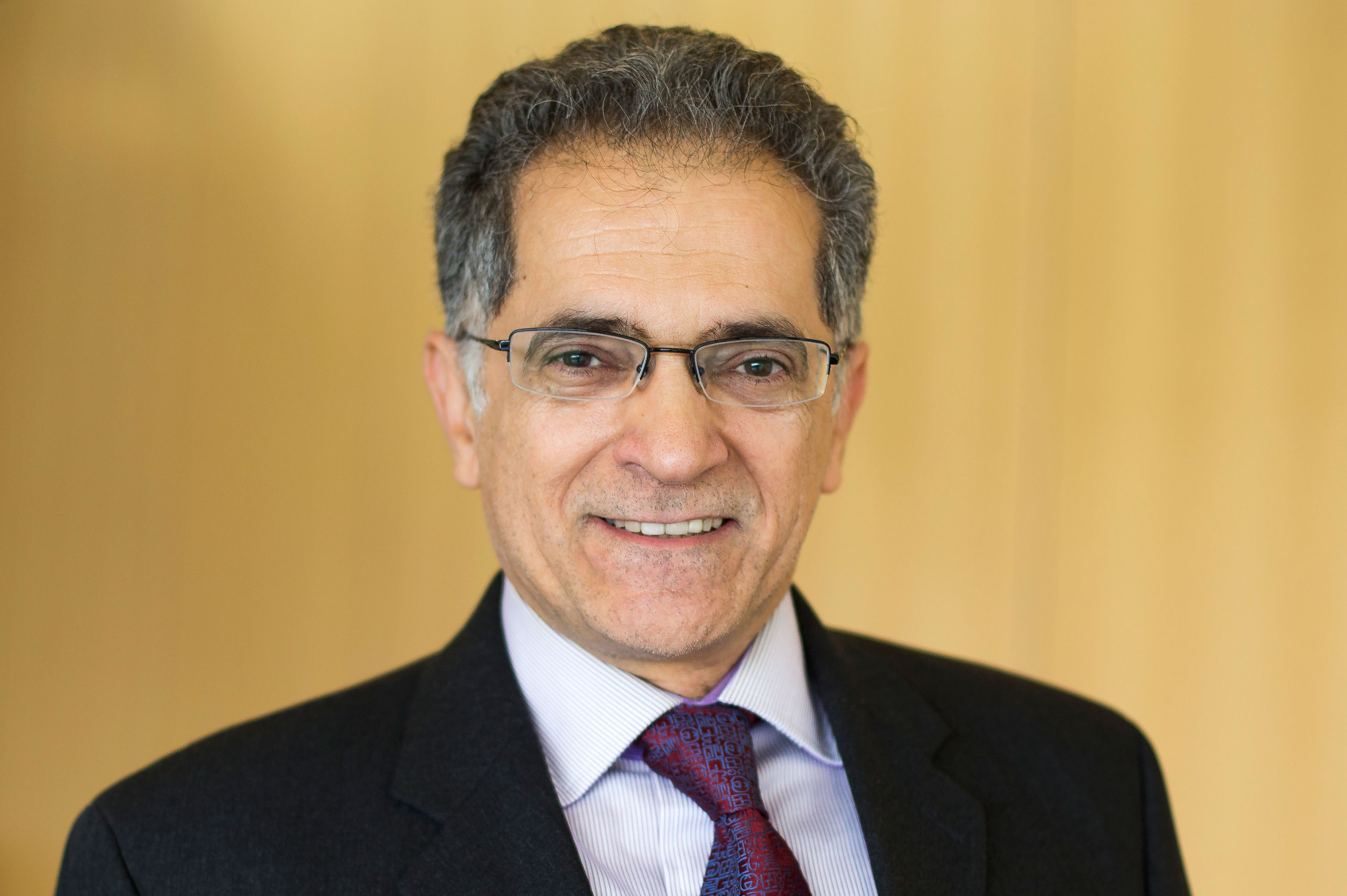
 Enlarge
EnlargeKamal Sarabandi

Whether acquiring data from the furthest boundaries of the solar system, assessing global warming, seeing through walls, or assisting communication among city dwellers or soldiers in the field, Prof. Kamal Sarabandi is strongly grounded in the basics. “The reason we can do such vast areas of research is that we are doing the research at the fundamental level considering various interactions of wave and the objects of interest.”
Prof. Sarabandi received his training among the best, here at Michigan. He now leads where he once trained, as director of the Radiation Laboratory, a position he has held since 2000. The RADLAB is composed of eight faculty, 4 research scientists, and nearly 50 graduate students who conduct research in areas as diverse as antennas, metamaterials, computational electromagetics, radio frequency (RF) propagation, microwave circuits, remote sensing, and plasma electrodynamics.
Prof. Sarabandi and his research group explore new avenues of research, such as the use of metamaterials, while they continue to expand knowledge in microwave and millimeter-wave radar remote sensing—an area he has worked in for more than twenty years. In recognition of his accomplishments, he received the 2005 Distinguished Achievement Award from the IEEE Geoscience and Remote Sensing Society.
Reaching into Space to Learn More about Earth
Prof. Sarabandi has been interpreting data from space for more than a decade—relating it to issues of global warming, and providing the data for scientists doing environmental research. “We need to protect our planet and understand what is really happening,” stated Kamal.
NASA plans to establish a base station on the moon by 2020 to aid continued space exploration. Kamal is already planning the instrumentation that would be used on this lunar base station to observe processes occurring on the earth that would be impossible to do any other way. He predicts it could be possible to measure small relative motions of land masses, including earthquake activity, which could lead to an ability to predict earthquakes.
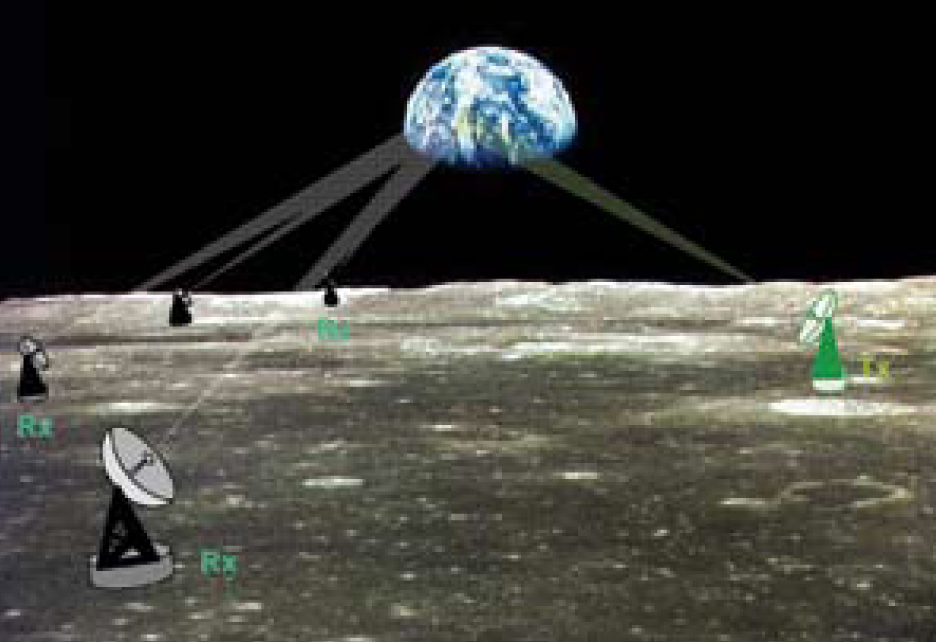
 Enlarge
Enlarge
Meanwhile, NASA probes are being sent to the far reaches of the solar system—collecting data, and taking pictures, video, and radar images as they go. Getting the information back is a challenge, and the main stumbling block is the antenna—Kamal’s specialty. The cost of an antenna large enough to transmit information efficiently is about $1B. Kamal has been working on a new technology that will emply a large array of smaller antennas, thousands of them, working together to create, in effect, a very large aperture. Until there is a lunar base station, which would simplify the phase calibration of these antennas, the moon will be used as a calibration target using InSAR (Interferomatetric Satellite Aperture Radar) imaging techniques.
“We need to protect our planet and understand what is really happening.”
Keeping earth science as an important activity within NASA is a high priority for Kamal, who has been recently appointed to an advisory committee charged with planning the future activities of NASA. “There is really no other agency with the expertise to deal with all the components that are needed for observing earth as a system, including designing instruments, launching satellites, and interpreting and distributing data,” he said. “Space exploration needs to incorporate continued remote sensing of the earth.”
Remote Sensing for Safety and Security
Here on earth, Prof. Sarabandi has developed important tools and methods in the area of radar remote sensing to study complex systems such as carbon cycle, which affects global warming, and soil moisture and snow, which can reveal problems related to hydrology, ecology, and climate. Radar remote sensing also has a wide variety of applications related to security and safety.
One newly-funded project investigates the use of radar to penetrate through walls and create a map of the interior to see if there are people or weaponry inside. He is collaborating with Ohio State University and the company Science Applications International Corporation (SAIC) in this project. Based in California, SAIC recently opened an Ann Arbor office for their Reconnaissance and Surveillance Operation.
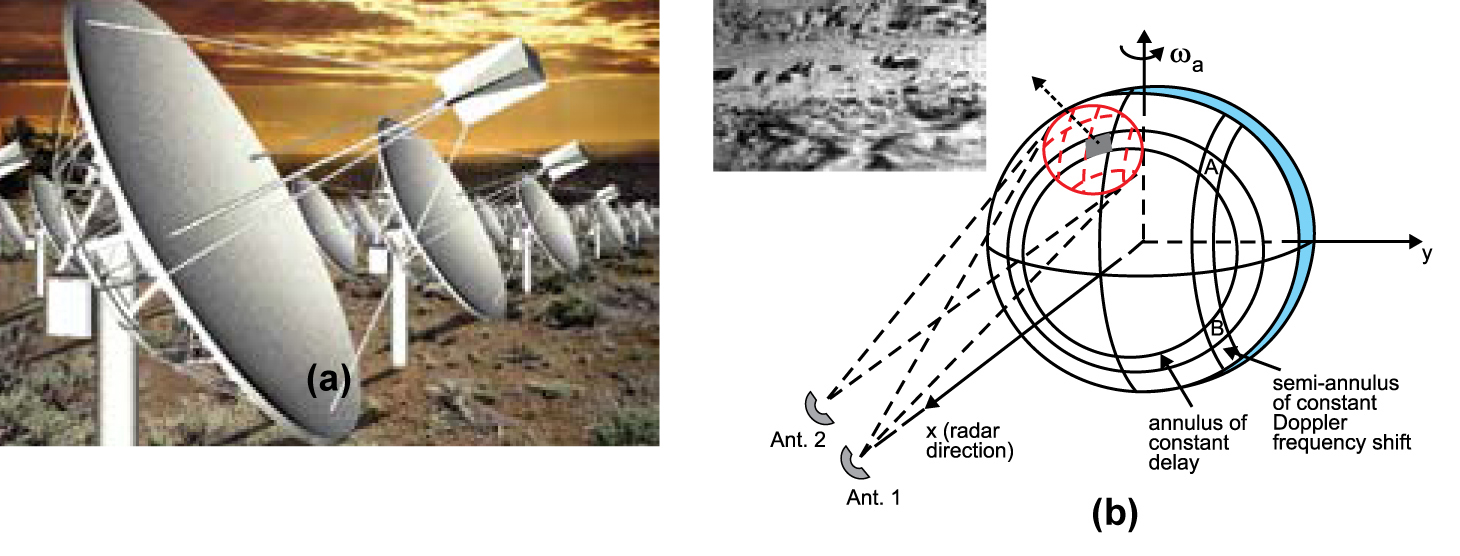
 Enlarge
Enlarge
Kamal is also working on a related system that can scan a crowd and determine whether or not people are concealing weapons. This will enable quick, broad coverage of an area. Suspicious individuals may then be pulled aside and asked to stand in a device that will “see” through clothing, such as was recently implemented at the Phoenix airport.
Turning his attention to safety issues, Kamal is developing a millimeter-wave radar system that will be mounted on helicopters to map the terrain underneath. Pilots are subject to highly dangerous landing conditions when landing in either snow or dusty/sandy regions. It is also impossible for them to know what lies beneath the immediate surface, such as a ditch or a rock. The new technology will enable pilots to see through white-out or brown-out conditions, and to know on what kind of surface they are landing.
Prof. Sarabandi explains that his research can reach into such a wide variety of areas because applied electromagnetics is a highly successful disciplines with significant impact on a wide range of technologies. With the wall penetration project, for example, once he determines the science of what happens to a wave or signal as it penetrates a wall, he will undo what the wall did to the signal and reconstruct the image.
Communication through Waves and Sensors
With satellites in space and cell phones on the earth, the U.S. population is coming to expect near instant communication. Losing a connection with someone even for a moment becomes very frustrating. The situation becomes downright dangerous for troops communicating in the field.
Prof. Sarabandi has analyzed wave propagation in an urban environment for the purpose of wireless communication. His research, which has been commercialized, enables planners to establish base stations throughout a city to ensure coverage for an entire area. He is now turning his attention to providing our active troops with the same coverage, even when they are sent to unfamiliar territories.
To gather information about these areas, Kamal is developing miniature low-power unattended ground sensors to measure a variety of environmental variables, such as vibrations from vehicles and sound, as well as to transmit photos of the area and other information derived from radar. These electronic transceivers act as a network with each other, communicating information between nodes until the information is sent to a satellite, and ultimately to a base station. These sensors are only possible through the integration of miniature antennas developed by Prof. Sarabandi.
Antennas the Bottleneck and Key
“We can make microelectronics very, very small,” explains Prof. Sarabandi, “but the bottleneck eventually becomes the antenna.” It is extremely difficult to make antennas smaller without greatly sacrificing their performance, yet the growing number of wireless applications for low-cost, power-efficient, and miniature electronics makes this an important area for continued research. Perfecting antennas for a variety of uses has been a mainstay of Sarabandi’s research; he has five patents in the area of antennas, and another six in the patent process.
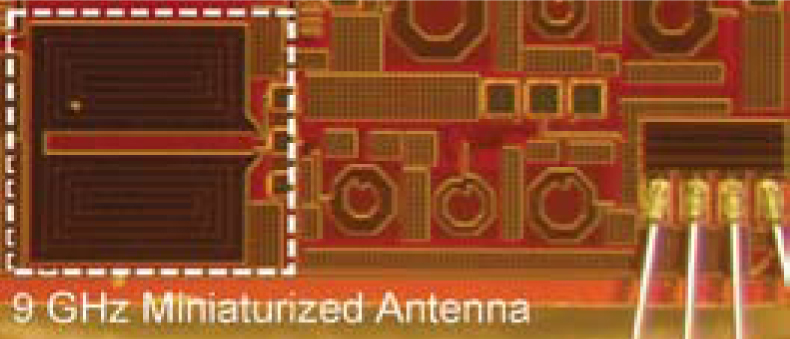
 Enlarge
Enlarge
When he was approached by Prof. Michael Flynn, a member of the Center for Wireless Integrated Microsystems, to collaborate on a project creating miniature environmental sensors, Kamal came up with a novel solution to the problem of integrating an on-chip antenna with a wireless transceiver on a CMOS IC with RF circuitry. The basis for his solution was an adaptation of the slot antenna. This tiny silicon-compatible antenna is capable of being mass-produced, and has potential applications in remote wireless environmental sensors, cell phones, and laptops. Sarabandi has already been talking with Intel about using the antenna design in wireless laptop computers. This breakthrough technology has been featured in EE Times.
Metamaterials for Antennas
The ability to shrink the size of an antenna while maintaining high efficiency is a tremendous challenge, with high dividends in potential applications. About five years ago, Prof. Sarabandi began to consider the use of artificial materials, called metamaterials, to achieve this result.
Working in Prof. John Halloran’s in the Materials Science Department, Prof. Sarabandi and his group took a rather simple ceramic material, similar to a
coffee mug, and used ceramic stereolithography to construct a 3-D monolithic millimeter-wave antenna with a sophisticated computer-generated pattern. An important characteristic of this metamaterial is its property of having both artificial permeability (µ) and permittivity (e), which presents significant potential for advancing RF/wireless front-ends. Kamal is able to control the index of refraction in different areas of this metamaterial and actually guide the wave and make it do what he wants.
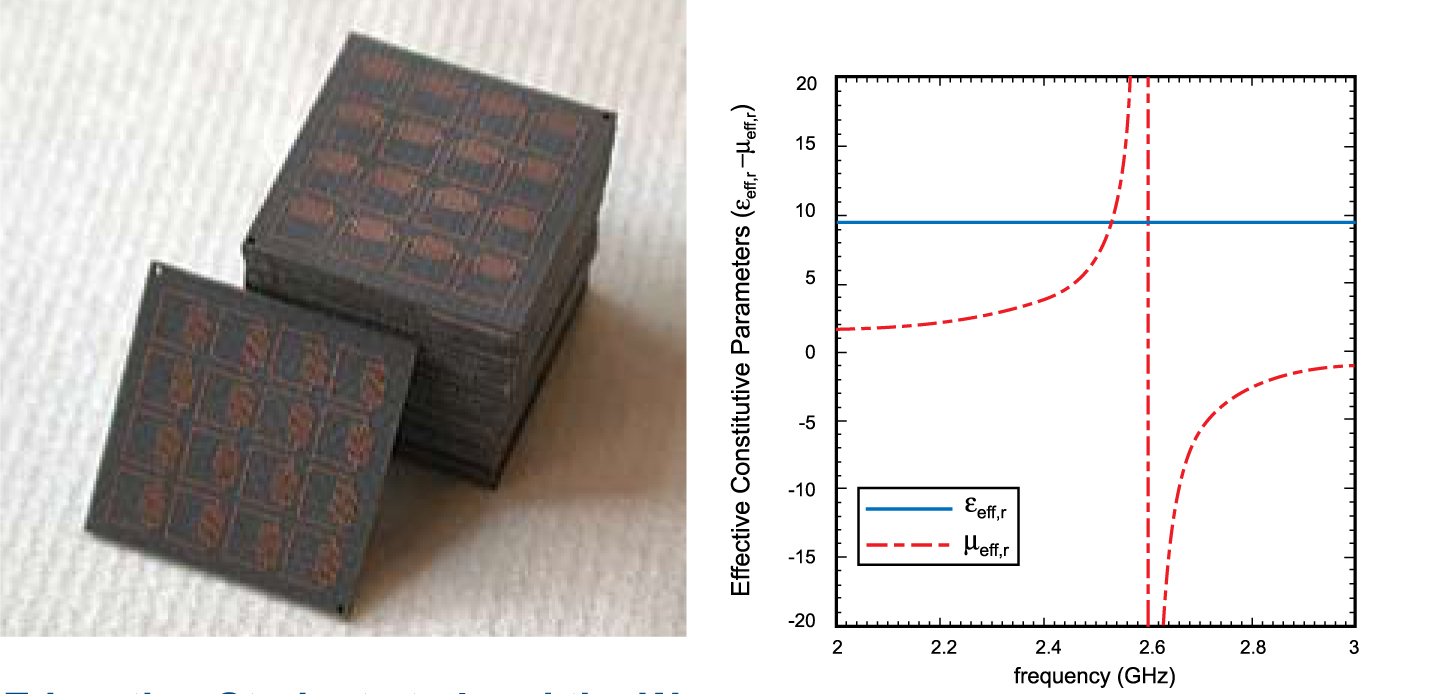
 Enlarge
Enlarge
Pictured to the right is the first Luneberg lens antenna constructed monolithically from this ceramic material. Potential consumer and military applications include use on an aircraft or on a military humvee, so that your laptop, or your soldier, can be in constant communication via satellite. This has already resulted in several patent disclosures. Prof. Sarabandi is working to reach the higher teraherz range of wavelengths with this technology, which would open an entirely new area of research effort.
Antenna size tends to be dictated by the frequency of the wave; the lower the frequency, the larger the antenna. However, it is not always feasible to have an antenna size that corresponds to the required frequency. For example, Army vehicles have extensive communications requirements with low frequency devices, yet it is not safe to outfit these vehicles with large, highly visual antennas. Prof. Sarabandi solved this problem by using a metamaterial known as Reactive Impedance Surface (RIS) permittivity substrate, which enables a significantly smaller antenna size on today’s and tomorrow’s Army vehicles. This work was recognized with a Best Paper award at the 25th Army Science Conference this past November.
Educating Students to Lead the Way
Prof. Sarabandi supports a large number of graduate students to help him conduct research in a wide variety of areas, some of which have been outlined above. “Our students are critical to the work we do here,” stated Kamal, “We are very fortunate at Michigan to have such high quality individuals.”
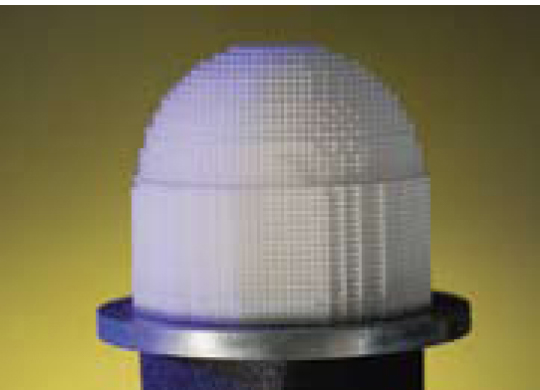
 Enlarge
Enlarge
The excellence of their work, combined with their focus on areas of high national interest, has resulted in a high number of student paper awards at recent conferences. Karl Brakora is a PhD candidate who has helped advance Kamal’s work in metamaterials. Already a prize winner for a paper in the area of ceramic stereolithography, which is employed in the Luneberg lens described above, Brakora recently had his work published in the IEEE Transactions on Antennas and Propagation. He spent much of his time in the lab creating these completely novel structures. “It’s really quite an accomplishment,” said Brakora, who appreciated Prof. Sarabandi’s patience through the extensive experimentation stage that goes into fabricating a completely new structure.
Prof. Sarabandi’s commitment to his students was recognized early in his career when he received a U-M Henry Russel Award for excellence in teaching and scholarship. Amy Buerkle, a PhD student working with Kamal on acoustic and electromagnetic wave interaction, appreciates his dedication and zeal. She recalled that, “at one of our meetings, he presented a sketch of a new idea on the back of an airline napkin.” As well as valuing his depth of knowledge and creative approach to solving problems, she stated, “he has demonstrated the importance of being well-rounded and using our ability as engineers to benefit society.”
Prof. Sarabandi wants his students to begin to build their careers here at Michigan, with a strong foundation in the fundamentals. “All of the work that I do is fed by looking at the fundamental issue of how wave interacts with other material,” stresses Kamal. “I want my students to have a solid foundation in order to move on to new areas once they leave Michigan. With a wide and deep knowledge of one field, you can do anything you want.”
 MENU
MENU 
